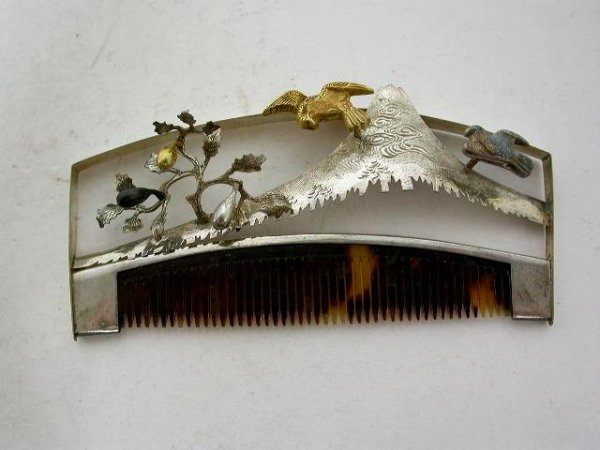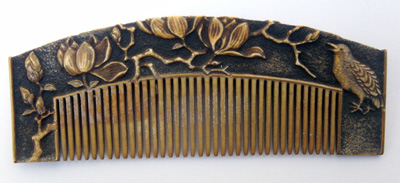Recently, two Japanese sets sold for $950 and $1100, respectively. They were both made of tortoiseshell in the Late Edo period. The first one has a leaf design on the kushi, while flowers rest in a field of grass on the kogai stick. It sold for $950 on July 31. You may refer to Item #330149236404.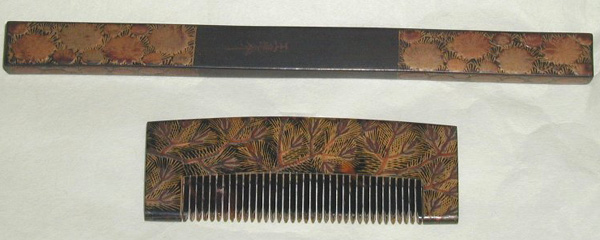
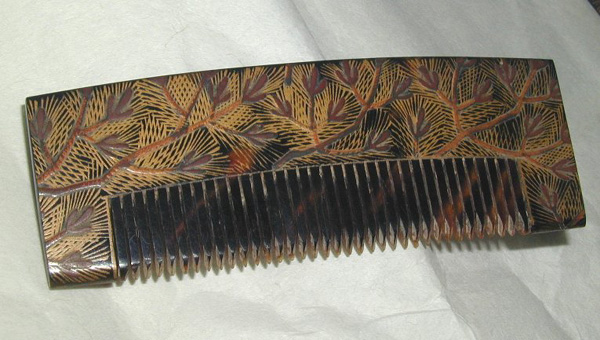
The second set had coral beads set into the kushi and kogai, as the gold maki-e decoration of flowers and leaves almost gives it the look of Imari porcelain. The kogai stick has beautiful gold and silver mounts that attach the oramental shell pieces to the stick itself. It sold for $1100 on August 2. You may refer to item #300135266043.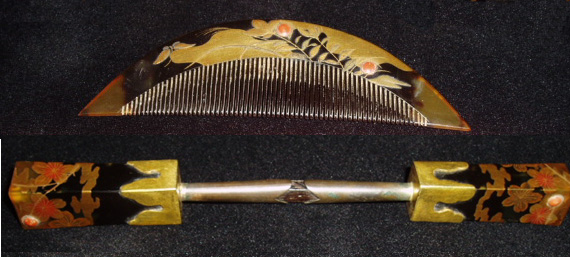
This beautiful Sterling silver comb with filigree leaves sold for $260 on July 30. I think it might be French, but I’m not sure. Comments welcome on this. I thought the design was distinctive and well balanced. You may refer to Item #160140008982.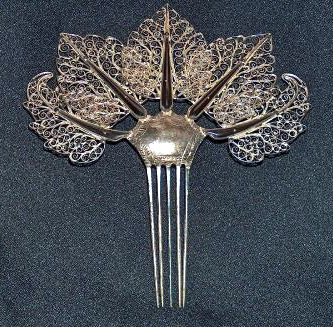
And finally today, I’ll show a comb a friend gave me pictures of. The dealer who showed it to her wanted $1200, and she is still undecided. It’s a beautiful Japanese Sterling silver, signed comb with a fish swimming in the water. Looking at the shape and size, I think it’s Meiji, although the design — one idea, and a fish — harks back to the Edo period. Comments welcome on this.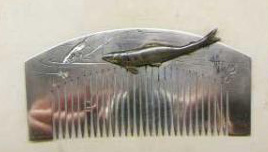
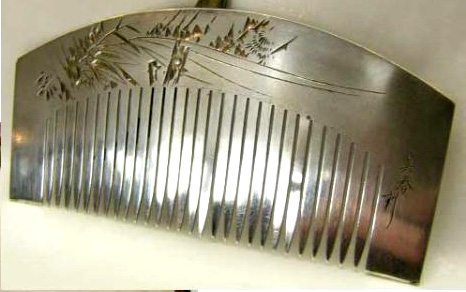
Category Archives: Edo Hair Comb
To Delight The Eye
I liked these. :-)
Edo comb, possibly Japanese hibiscus? 18th century.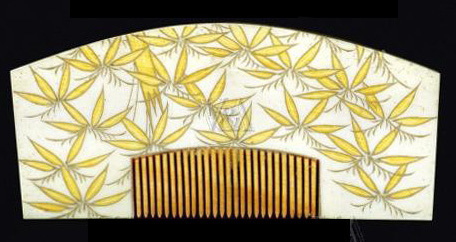
Liturgical comb of Boxwood inlaid with geometric marquetry & studded with silver. Italy, c.1500. The Italians were world renowned for intarsia wood craft during this period, the most famous example being The Gubbio Stuiolo at the Metropolitan Museum of Art.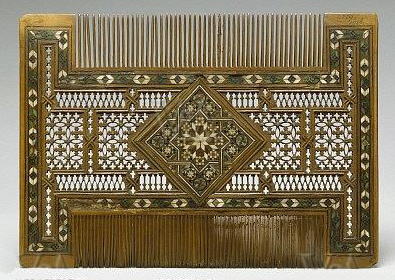
Here is a tiara from Rene Lalique, 1903-1904.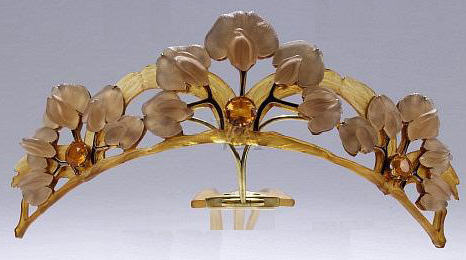
This is a lovely tortoiseshell comb by Alexander Parkes, England. c. 1870.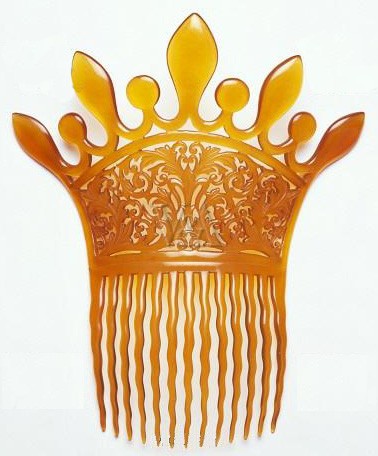
This winged ornament sat atop a tiara, which would be worn to the opera, perhaps a performance of Wagner “Die Walkure” (The Valkyrie). It is made of tortoiseshell, diamonds and pearls. France. c. 1900. 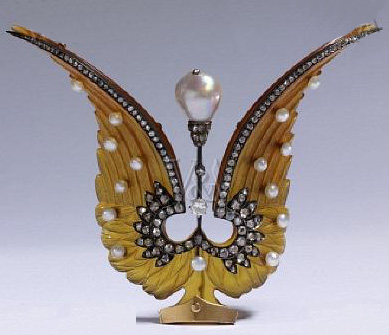
And finally, because I must… ;-) An English rose-cut diamond and pearl tiara, c. 1860. To die for. :-)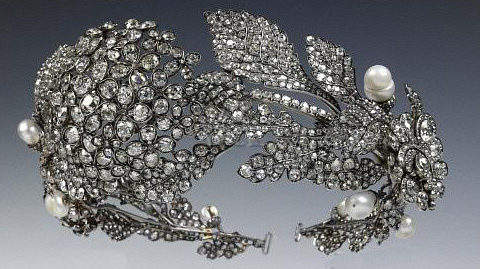
C’est la vie, peeps! Have a great month. :-)
Well, you had to wear them in something
Here are some 19th-century paintings of Geishas in their wigs, wearing the beautiful ornaments we all admire. It’s nice to see kushi and kanzashi in context. From the historical record these paintings provide, it looks like the wigs were just as creative as the combs.
Geisha with Sake Cup, by Keisai Yeisen (1789-1851)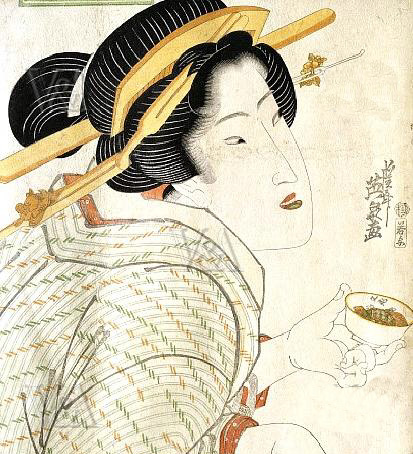
Courtesan with a fan, by Kitagawa Utamaro (1753-1806)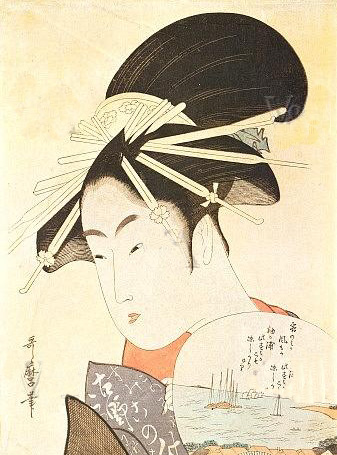
The Doll’s Festival, from the Furyu Goyo Matsu (Five Seasonal Festivals) Series, by Torii Kiyomitsu II (Torii Kiyomine) (1788-1868)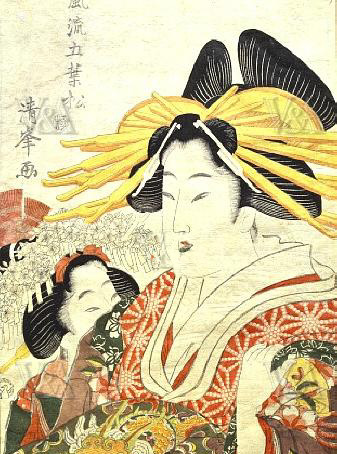
Beauties of the Yoshiwara at Daikoku House, by Keisai Yeisen (1789-1851).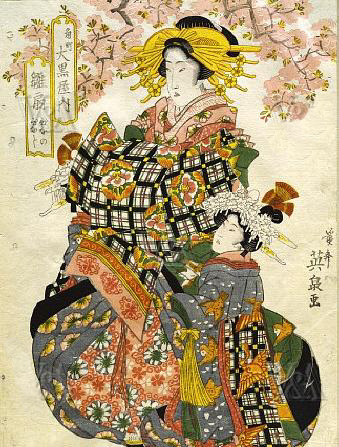
And on a BA-Life Personal Clutz Note: I’m glad my Japanese combs are in a case. Can you imagine balancing in one of those wigs, knowing you have these priceless tortoiseshell ornaments on, and you can’t fall? And the kimonos! Can you imagine walking in that and not falling? Who stopped wearing heels at 40? ;-)
I Love Japan :-)
Although I just did an article about kanzashi, these were so outstanding, I had to post. :-)
This blonde shell Sho-chiku-bai is beautifully balanced with plum, chrysanthemum, and bamboo. The artist even carved the chains on which the orchids hang out of shell. It was owned by the family of Prince Arisugawa Taruhito, who became the 9th head of one of the cadet branches of the Imperial Family of Japan in 1871, and was a career officer in Imperial Japanese Army. His collection is featured at the National Musuem of Japanese History.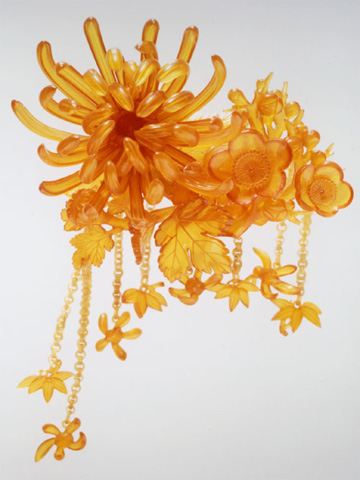
This tortoiseshell hairpin of plover birds flying over waves on a coral branch was also owned by Prince Arisugawa Taruhito. This one takes my breath away.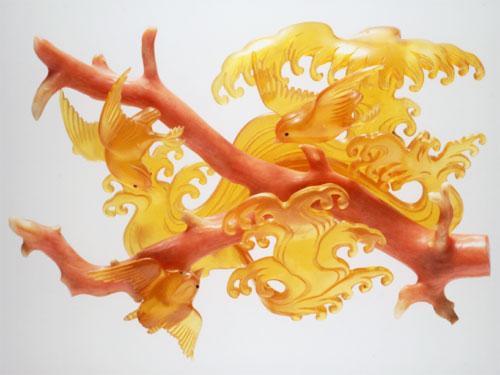
From the Nomura Shojiro Collection comes this Edo comb of a grasshopper busily eating while a larger animal looms. But are we seeing the animal’s horn, while his hungry eyes focus on that grasshopper? Or, does the line signify the larger animal’s tail, as he plods away completely unaware of the grasshopper’s existence. Japanese comb art plays with and mixes perspectives a lot, but this maki-e painting has all the players in one scene. The artist makes you imagine how each animal sees their world. In art school, teachers ask students, “What can you do with a line?” And I think this comb provides a wonderful answer because with one line, it goes from being beautiful to being great.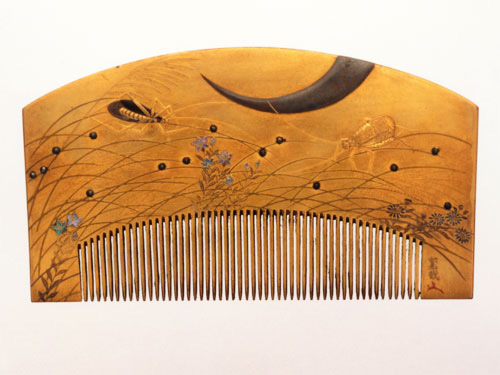
Edo Bird in Flight
Early Edo Japan is one of my two favorite periods of comb art. The other is French art nouveau. But recently, an Early Edo comb of a bird flying from a branch into the sunlight was featured on the web. What I love about this particular piece is that the paint is lighter where the sun is shining, so you get a perspective of the sunlight the bird is looking toward as it is jumps into flight. I’d say the piece is 18th-Century Edo, signed, in immaculate condition. You couldn’t put a price on this. It’s worth anything a collector would pay to get it.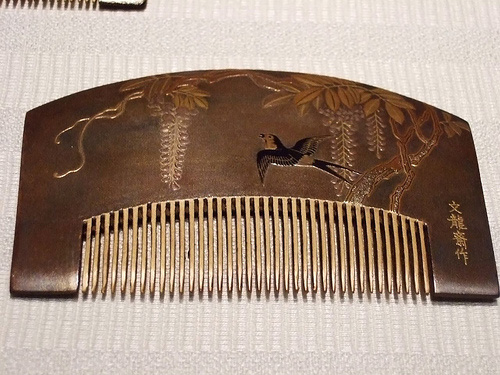
Some Lovely Things on Ebay
There have been some beautiful things listed recently, and I wanted to feature just a few of them. First is a lovely late Edo kushi whose Mt. Fuji landscape has great perspective and detail. The painting carries over the top edge of the comb. It is shell with gold maki-e, small applied gilt areas, and black lacquer lines. It was a Buy It Now for 435 UKP, and remained unsold.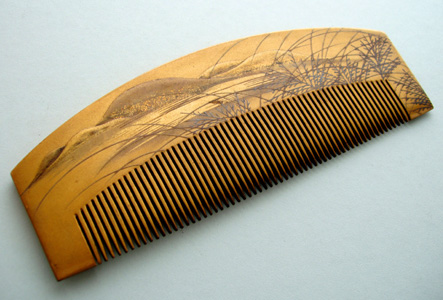
Next is an early Meiji tortoiseshell comb with beautiful raised gold carvings of a bird in a cherry blossom garden. It sold for $200 on October 18. Seller: webangelpb. Buyer: alain-t, a serious collector.
From 1850s England, a beautiful Georgian Sterling silver comb with a flower-filled urn at its crest sold for $155.50 on Oct 30. The seller was neatstuffdave. 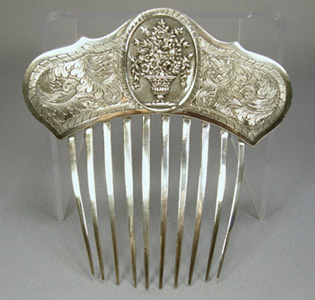
Last is a splendid Victorian Sterling hair comb with mythical figures in three cabachons. It has a maker’s mark and sold for $272.59 on Nov. 1. Buyer: myrnatoo, another serious collector. 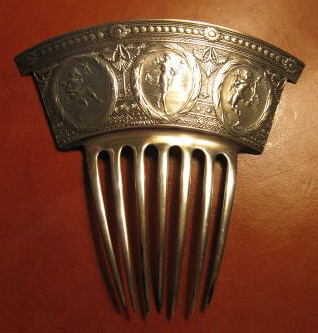
Hemp/Hibiscus? and Chimeras in Early Edo Japan
I am changing the text on this 18th-Century Edo comb about hemp because of an excellent, edifying comment by msctaiyang, a serious collector of Japanese hair combs. She said, “Regarding the hemp – it has been a medicinal herb in Chinese and Japanese medicine for centuries and to this day the treated seeds are used in many over the counter preparations. It is called Hua Ma Ren (ren means seed) and is used among other things to unblock the intestines. So hemp is really part of Japanese and Chinese culture, but in a much more utiltarian (and sensible) way than here in the States.” The comb is shell with black lacquer and gold paint. Although after seeing the flowers on a Japanese Hibiscus, the artist might have meant those.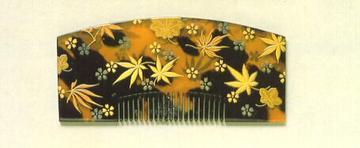
This wooden comb is 17th-Century Edo. You can tell by the size, artistic style, and subject. It’s one idea on a large comb canvas is a chimera behind a folding screen.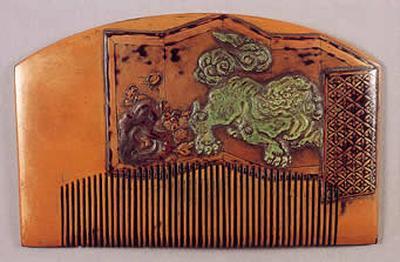
My Favorite Combs
Two historical periods created my favorite combs: Edo Japan and Art Nouveau France. The artistry embodies two completely different concepts, one painting and inlay on a flat ivory surface, the other an orchid sculpture or horn, ivory and glass made by Rene Lalique with his own hands. Examples:
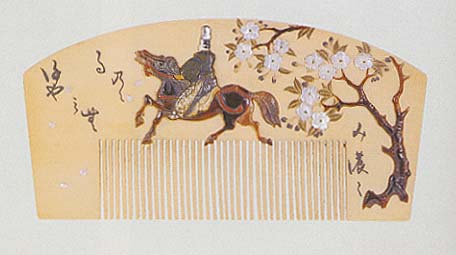
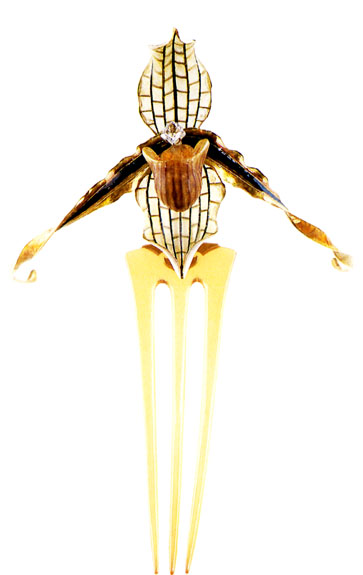
Edo, Silver and Shell
For Japanese collectors, a silver and tortoiseshell comb from the Edo era, with the silver carved into birds on Mt. Fuji and the kogai made to match, is a treasure rare to behold. I believe there is a drop pearl hanging from the bonsai tree on the left. The artwork is museum level on this comb, even though the condition was not at its best. It sold for $1300 at live auction. I and another Japanese collector bid $750 and $800, respectively, but we couldn’t get our hands on it.
